Pekka Buttler, 11/2022 (Updated 11/2024)
Specifications
The tables below summarises key specifications of two quite different samples
Exakta-mount sample from ca. 1949
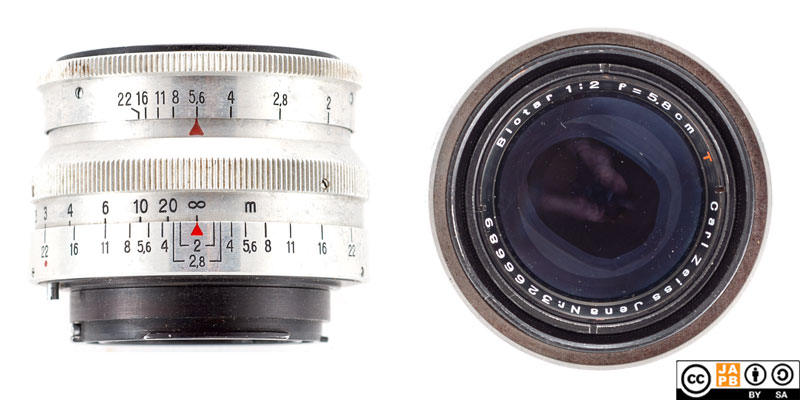
| Brand: | Carl Zeiss Jena | Lens name | Biotar 1:2 f=5,8cm T |
| Focal length(s) 1 | 58 mm | Angle-of-view 2 | 40 ° |
| Maximum Aperture | f/2 | In Production | 1936–1961 (all variants) |
| Lens mount (this lens) | Exakta | Other lens mounts | M42, Praktina, Praktiflex |
| Length 3 | 33,5 mm (Exakta version) | Diameter 4 | 49,9 mm (Exakta) |
| Filter ring diameter | 40,5 mm (Exakta) | Weight | 143 grams |
| Lens element count | 6 | Lens group count | 4 |
| Aperture blades (S/R/C) 5 | 17 S (Exakta) | Focus throw | 190 ° (Exakta) |
| Minimum focusing distance | 90 cms (Exakta) | Maximum magnification | 1:13.4 |
| Has manual aperture ring | YES | Has Manual focus ring | YES |
| Aperture mechanism type | Manual | Aperture click stops | None (clickless) Range f/2–f/22 |
Praktina-mount sample from ca. 1955
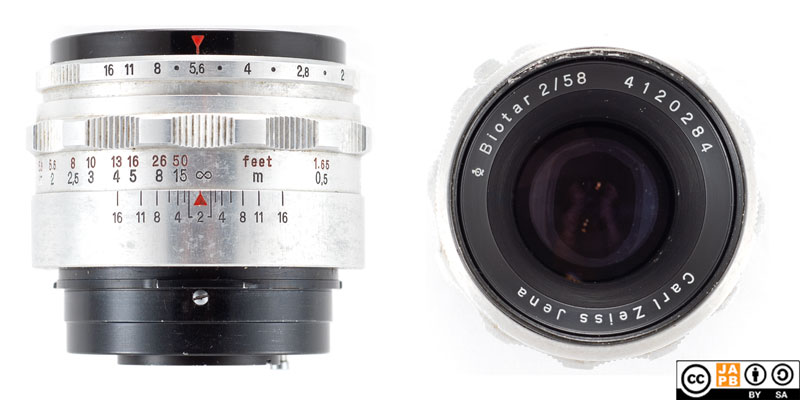
| Brand: | Carl Zeiss Jena | Lens name | Biotar 1:2 f=5,8cm T |
| Focal length(s) | 58 mm | Angle-of-view | 40 ° |
| Maximum Aperture | f/2 | In Production | 1936–1961 (all variants) |
| Lens mount (this lens) | Praktina | Other lens mounts | Exakta, M42, Praktiflex |
| Length3 | 38,6 mm | Diameter4 | 59,9 mm |
| Filter ring diameter | 49 mm | Weight | 213 grams |
| Lens element count | 6 | Lens group count | 4 |
| Aperture blades (S/R/C)5 | 10 S | Focus throw | 315 ° |
| Minimum focusing distance | 50 cms | Maximum magnification | 1:6.5 |
| Has manual aperture ring | YES | Has Manual focus ring | YES |
| Aperture mechanism type | Semi-automatic aperture | Aperture click stops 6 | 2•2.8•4•5.6•8-11-16 (Locking clicks) |
Further notes:
• The Biotar was manufactured during 4 decades and observed the development of professional and enthusiast photography from a ringside seat. Hence, its development very much echoes that of the photographic industry during the 30s–50s. See ‘versions’ below)
• Due to the Zeiss East and Zeiss West trademark dispute (see below), some Carl Zeiss Jena Biotars were sold in international markets without reference to the word ‘Biotar’ (the lenses were simply indicated by the letter ‘B’
• The 58/2 Biotar is by no means an especially rare lens, but its greatest impact on the photographic world is twofold:
• a) that it showed that Paul Rudolph’s 1896 Zeiss Planar design could be made into a working, general purpose lens
• b) the fact that it acted as (depending on who you listen to) either ‘blueprint’ or ‘inspiration’ for the countless millions of Soviet Helios-44 lenses
• Incidentally, the early Carl Zeiss Jena Biotar is very small for being a bright, standard SLR lens. The picture below shows a 1949 Biotar next to a Jupiter-8 (Soviet remake of the 50/2 Sonnar) rangefinder lens and a box of matches. Admittedly, not all versions of the Biotar are as small as the manual-aperture Exakta version pictured below.
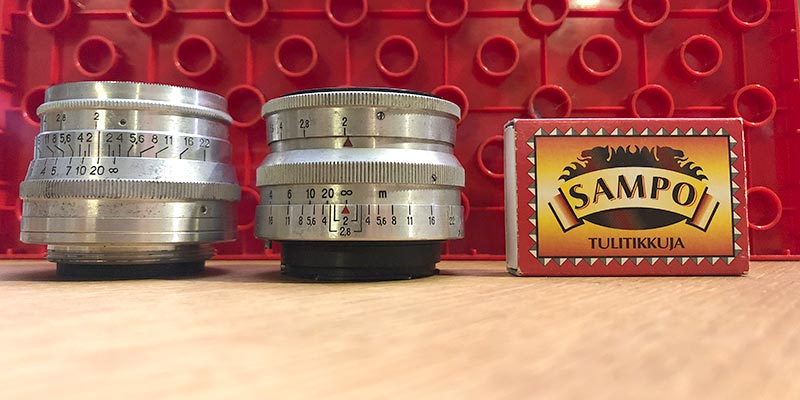
History of Carl Zeiss Jena
There are few names in camera optics more illustrious than that of Carl Zeiss. The company was founded in the German town of Jena in 1846 by Carl Zeiß (hence: ‘Carl Zeiss Jena‘). During 1846–1945 there are few major developments in lens optics that the company was not involved in. Names that are even today well-known in optics – such as Planar (1896), Tessar (1902), Sonnar (1929), and Biotar (1939) (as well as many names that only optics-buffs know) – were the product of Zeiss’ first century of technological innovation.
After the Second World War Germany was divided into a Soviet zone (subsequently: East Germany) and the west-allied zones (subsequently: West Germany). While the Zeiss works resided in Jena (optics and glasses) and Dresden (cameras), which were in the Soviet sector, a contingent of Zeiss managers decided to move west and ended up setiting up shop in the small town of Oberkochen in the American sector under the name of Opton Optische Werke Oberkochen GmbH. As the relations between the former allied deteriorated and the split into East and West Germany became all the more real, the Oberkochen works changed their name first to Zeiss-Opton and later to Carl Zeiss.
What ensued was a lengthy international trademark dispute with both Zeiss’ (Jena and Oberkochen) laying claim to the name ‘Carl Zeiss’. The resulting stalemate – emblematic of the Cold War in its entirety – resulted in that Carl Zeiss Opton was allowed to use the name Carl Zeiss in the West, but had to use the Opton brand in the East bloc, whereas Carl Zeiss Jena was the only real Carl Zeiss as far as the east bloc was concerned, but could – mostly – not use the Carl Zeiss -name for exports to the West 7. The fact remains however, that – starting in 1946 from a shared base – Jena and Oberkochen developed as two independent companies for more than 40 years. After German reunification also Zeiss East and Zeiss West were united again, and have since again been at the undoubtable forefront of lens development.
This lens harkens to the time of the cold-war and the East/West split. During the entire Cold War period, VEB Carl Zeiss Jena was seen by the country’s leadership both as a paragon of the East German technology industry and a showcase of the socialist/communist system as well as a major source of exports (and hence, western currencies). Within the centrally directed economy’s hierarchy, Carl Zeiss Jena therefore had a more prestigious role than other East German optics manufacturers (prominently Meyer-Optik Görlitz and, later, Pentacon), meaning that Carl Zeiss Jena received privileged access to tools and materiel (including the first computer in East Germany) and that its products were always considered the premium alternative.
History of the Biotar
While the Biotar design is not as famous as some other Zeiss designs (especially Planar, Sonnar and Tessar) this is partially due to that the Biotar was not especially long-lived. Still, when considering the overall impact, the Biotar is by no means a slouch. While most modern fast standard primes for SLRs can be characterised as designs derived from the ‘Planar’, the same can be said of the Biotar. Moreover, one could argue that as the Biotar was the first Planar/Double Gauss design that managed to fulfil the Planar’s original (anno 1896) promise, those lenses that are today referred to as ‘Planar’ designs, should, in fact, be called ‘Biotar’ designs. Read on…
The 1896 Planar and its problems
Paul Rudolph famously looked at the Double Gauss lens design by Alvan Clark (1888), found it had potential, but that it was also fundamentally troubled. Rudolph replaced Clark’s double Gauss’ inner pair of single lenses with doublets, thereby creating a highly symmetric, relatively well-corrected lens. Because the lens (being symmetrical) offered a flat focal plane (negligible field curvature), Rudolph coined it the Planar.
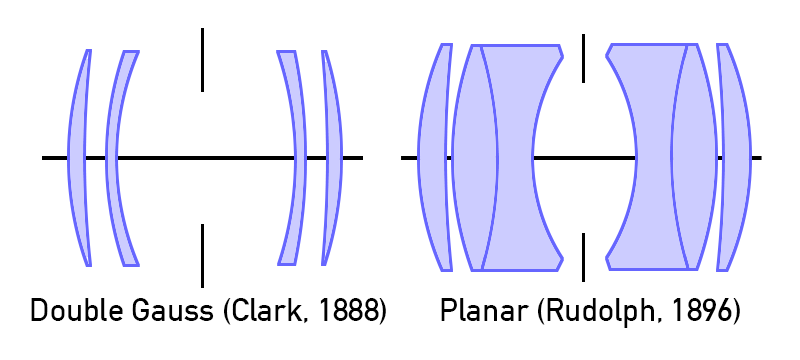
However, the original Planar – for all its marvellous features – had some serious drawbacks, especially when compared to other contemporary designs. Firstly, compared to most contemporary lenses, the Planar had too many air-glass interfaces (8, altogether), leading to loss of transmission, and a tendency towards veiling flare, further exacerbated by a special tendency (caused by the interplay of lens shapes) to produce significant internal reflections. Moreover, to really fulfil its potential, the Planar demanded manufacturing tolerances that were beyond what the optical industry regularly achieved. Combined with the high cost of producing a marvel such as Rudolph’s brainchild, the Planar did not stand a chance to become a general purpose photographic lens, instead it remained mainly a specialty reproduction lens (a situation where lighting could be precisely controlled to combat veiling and internal reflections).
During the subsequent three decades, several prominent lens designers tried to improve on Rudolph’s original Planar, including H.W. Lee at Taylor&Hobson, and Rudolph himself. In most cases improvements in both optical characteristics and maximum aperture were achieved (with the Taylor&Hobson Opic (1920) reaching f/2) at the cost of letting go of the original idea of a strictly symmetrical lens. But at the same time, the Planar’s bane (veiling and internal reflections) remained insufficiently addressed.
Enter Willy Merté and the Biotar
While glass science had developed considerably during the decades since the original Planar, lens coatings were to be invented only in 1935. Hence, Zeiss lens designer Willy Merté’s modification of Rudolph’s Planar in 1927 that managed to lessen veiling and largely eradicate internal reflections must be deemed a stroke of genius. Merté’s hack was based on changing the shapes of the original Planar’s lens elements in such a way as to direct a majority of internal reflections away from the image centre and into the lens’ baffles, hence being able to produce a Planar that could become a general purpose photographic lens. While Merté’s Biotar was originally only offered as a 25 mm f/1.4 lens for 16 mm motion picture cameras, that was quickly extended with a 50 mm f/1.4 (again for 16 mm film).
When it in the 1930s became obvious that a new format – the “35 mm film” – was going to be something big – as evidenced with the early success of the Leica I (introduced 1930) and the Kine Exakta (introduced 1936), The Biotar was rapidly redesigned to cover the 36×24 mm film, hence producing the 1936 Zeiss Biotar 58 mm f/2 for the Kine Exakta.
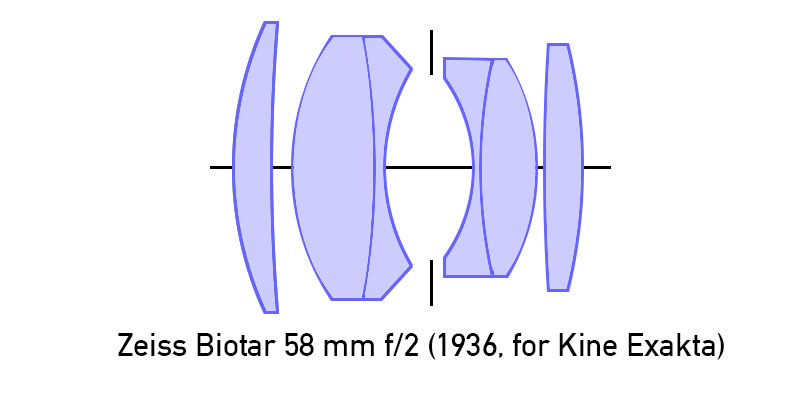
The Biotar further got an upgrade in 1939 in the form of staring to use coatings. Then WW2 broke out and civilian applications were relegated to the desk drawer.
Post-war Biotars
After hostilities ended, and even though most of Germany lay in ruins and a lot of Zeiss machinery and parts were making its way to the Soviet Union as ‘war reparations’, production of photographic lenses quickly restarted at Carl Zeiss in Jena. And the Biotar was one of their absolute hit products. Moreover, beside the (original) Exakta mount, Biotars were also being manufactured for the new mounts (such as M42, the Praktina mount and others).
The end of the Biotar.
Carl Zeiss Jena stopped manufacturing the Biotar in 1961. This was caused by several factors. First, the combination of 58 mm and f/2 was becoming less and less attractive and the competition (both German and Japanese) was offering both wider (50/2) and faster (58/1.4) designs for standard lenses. While The Biotar at this stage was only 25 years old, those years were an era of massive change, and the 1936 design was simply outdated and had to be replaced. Second, due to the trademark dispute between Zeiss East and Zeiss West (which forbade Zeiss East the use of the Biotar name in western markets), Carl Zeiss Jena did not have a strong interest in hanging on to the ‘Biotar’ name. On the contrary, Carl Zeiss Jena was actively looking for a new moniker that Zeiss West could not lay claim to. These two forces coincided into the launch of the Carl Zeiss Jena 50/2 Flexon, which was quickly renamed the 50/2 Pancolar (you can continue reading the story with Data Sheet: CZJ Pancolar 50/2).
Epilogue
As Steve Jobs used to say: “One more thing”, because the story of the Biotar did not end with Carl Zeiss Jena’s decision to stop its manufacture, because – in essence – the lens remained in production until 1990, as the Soviet Helios-44 lens [data sheet].
I’m not saying that the Biotar and Helios-44 are identical, because they are not. Then again, neither was the 1936 CZJ Biotar identical with the 1958 CZJ Biotar, so saying that the 58 mm f/2 Helios-44 and the 58 mm f/2 Biotar share more DNA than humans and chimps is not a stretch.
Versions
There are four distinct versions of the Carl Zeiss Jena Biotar 58 mm f/2, but as Carl Zeiss was constantly innovating, considerable variation exists within the versions:
• Version 1: “Pre-war” (1936–1945): 8-bladed manual aperture; Exakta-mount; ≈380 grams; MFD 0,9 m; Filter 40,5 mm; coated after 1939
• Version 2: “Manual” (1946–1952): 17-bladed manual aperture; Exakta, M42 or Praktiflex mount; ≈210 grams for chrome-brass version; ≈140 grams for aluminium version; MFD 0,9 m; Filter 40,5 mm

• Version 3: “Preset” (1950–1954): 10 or 12 bladed preset aperture; Exakta, M42 or Praktina mount; ≈ 200 grams; MFD 0,5 m; Filter 49 mm
• Version 4: “Semi-automatic” (1953–1961): 10 bladed semi-automatic aperture; Exakta or M42 mount; ≈215 grams; MFD 0,5 m; Filter 49 mm

Adapting
(The discussion below will focus on adapting M42 and Exakta variants. For a discussion on adapting Praktina mount variants, see JAPB’s article on the Praktina mount. For other mounts, be in touch, and I’ll try to help as best I can.)
This lens cannot be used natively on any current SLR or dSLRs. To use it in its native environment, you will need an Exakta or M42-mount film body. Luckily there are a lot of those (especially in M42 mount) available.
Thanks to being a fully manual lens (manual aperture, manual focus), the lens can be adapted to all mirrorless cameras using a suitable adapter. Moreover, both Exakta and M42 lenses are so uncomplicated that a simple ‘dumb adapter’ will do the job perfectly. Moreover, due to the popularity of both mounts, special adapters (helicoid adapters, tilt/shift adapters) are readily available. Alternatively, one can choose to daisy-chain adapters (e.g. M42->Canon EF; Canon EF –> mirrorless) which also opens up a wide range of speed boosters for those photographers that use smaller than full-frame sensors.
Using m42 and Exakta lenses on dSLRs can also be an easy option, depending on which dSLR.
• Canon EF has the shortest flange focal distance among full-frame dSLR’s and Canon’s wide range of dSLRs are able to mount both M42 and Exakta lenses perfectly using a simple adapter ring.
• Minolta / Sony A dSLRs are likewise able to mount M42 lenses using a simple adapter ring, but for Exakta lenses, the difference in flange focal distances is not enough to enable reaching infinity focus without an adapter that uses corrective optics.
• Pentax K dSLRs are likewise able to use M42 lenses using a simple adapter ring, but for Exakta lenses an adapter that uses corrective optics would be needed to allow infinity focus.
• Nikon F dSLRs have a long flange focal distance, meaning that mounting either M42 or Exakta lenses needs an adapter that uses corrective optics to allow anything close to infinity focus.
Footnotes
- Focal length is (unless stated otherwise) given in absolute terms, and not in Full-frame equivalent. For an understanding of whether the lens is wide/tele, see ‘Angle-of-view’. ↩︎
- Picture angle is given in degrees (based on manufacturers’ specs) and concerns the diagonal picture angle. Rule of thumb:
> 90 ° ==> Ultra-wide-angle
70–90 ° ==> Wide-angle
50–70 ° ==> Moderate wide-angle
40–50 ° ==> ‘Standard’ or ‘normal’ lens
20–40 ° ==> Short tele lens
10-20 ° ==> Tele lens
5-10 ° ==> Long tele lens
< 5 ° ==> Ultra-tele lens ↩︎ - Length is given from the mount flange to the front of lens at infinity. ↩︎
- Diameter excludes protrusions such as rabbit ears or stop-down levers. ↩︎
- S=straight; R=rounded; C=(almost)circular at all apertures. ↩︎
- Numbers equal aperture values on aperture ring; • intermediate click; – no intermediate click. The Biotar for Praktina uses locking clicks, meaning that the user would have to pull the aperture ring towards the camera to be able to change the aperture value – a trait clearly inherited from preset lenses. ↩︎
- Online one can find many lengthy and heated disputes stating that only Jena/Oberkochen is the true Carl Zeiss. While many of these discussions are riddled with misconceptions and a poor grasp of facts and timings, they largely also tend to be tainted by ideologies. Those discussions that focus on claims of one or the other Zeiss not really having rights to using designs developed at pre-war Zeiss are especially ludicrous because after the war practically the entire patent catalogue of pre-war German patents was given freely to everyone (the allied saw this as a form of reparations), hence also kickstarting the Japanese optics industry’s ascendancy (the Japanese optics companies were the most avid users of German optics patents). ↩︎